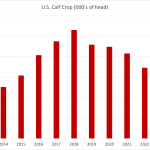By Glen Hallick, MarketsFarm
WINNIPEG, April 27 (MarketsFarm) – Intercontinental Exchange (ICE) canola futures continued upward on Wednesday, setting more new highs in a number of contracts before stepping away.
The main impetus of today’s increases came from sharp spikes in Malaysian palm oil, following a policy reversal by the Indonesian government. On Monday, the government stated that crude palm oil was excluded from its ban on palm oil exports. However, in citing the need to get control over rising domestic food prices, the government reversed course to make CPO part of the ban along with refined palm oil.
Read Also
Canadian Financial Close: Loonie weakens
By Glen Hallick Glacier Farm Media | MarketsFarm – The Canadian dollar pulled back on Monday, due to a lack…
The change of heart also pushed up the Chicago soy complex, but European rapeseed finished lower. Small gains in global crude oil prices provided a little bit of support for edible oils.
While spring planting is well underway in parts of Alberta, such is very likely to be delayed to mid-May on much of the eastern Prairies.
The Canadian dollar was slightly lower at mid-afternoon, with the loonie at 77.95 U.S. cents, compared to Tuesday’s close of 78.14.
There were 18,306 contracts traded on Wednesday, which compares with Tuesday when 27,767 contracts changed hands. Spreading accounted for 8,922 contracts traded.
Settlement prices are in Canadian dollars per metric tonne.
Price Change
Canola May 1,218.60 up 17.70
Jul 1,208.80 up 14.00
Nov 1,112.60 up 4.80
SOYBEAN futures at the Chicago Board of Trade (CBOT) were stronger on Wednesday, pulled by the spike in Malaysian palm oil values.
As the United States dollar reaches highs unseen in 20 years, the Brazil real has been hitting all-time lows. That will make the latter’s soybean and corn imports more attractive to foreign buyers.
The USDA attaché in Argentina forecast that country’s planted soybean area in 2022/23 to expand nearly four per cent at 17 million hectares, with yield expected to jump 19.5 per cent at 3.09 tonnes per hectare.
ANEC estimated Brazil’s soybean exports in April should reach 1.93 million tonnes, 22.5 per cent more than the previous April.
CORN futures were also stronger on Wednesday, due to spillover from soybeans.
The U.S. Energy Information Administration said ethanol production for the week ended April 22 averaged 963,000 barrels per day, up 1.7 per cent from the previous week. Ethanol stocks were down 1.5 per cent at nearly 23.97 million barrels.
UkrAgroConsult has found that five per cent of Ukraine’s grain elevators have suffered collateral damage and 15 per cent are inaccessible due to destroyed infrastructure.
Brazil’s top corn-producing state, Mato Grosso has been contending with its driest April in 17 year, posing a threat to its crops. Mato Grosso was projected to harvest 40 million tonnes of safrinha corn out the country’s expected 88.5 million tonnes.
WHEAT futures were mixed on Wednesday, with gains in Minneapolis but losses in Chicago and Kansas City.
Upwards to five inches of rain in the coming seven days has been forecast for South Dakota, with the surrounding Northern Plain states to receive lesser amounts.
The EU lowered its estimate for 2022/23 wheat yields by almost 1.2 per cent due to dryness in Hungary and Romania. The EU is now expecting 5.95 tonnes per hectare.








